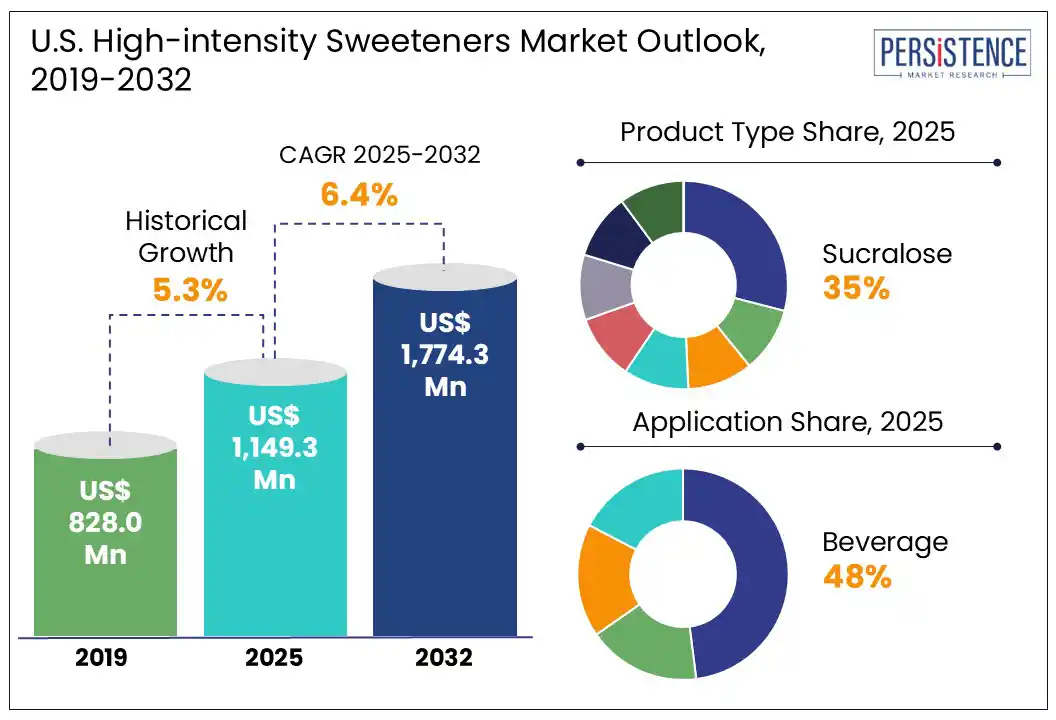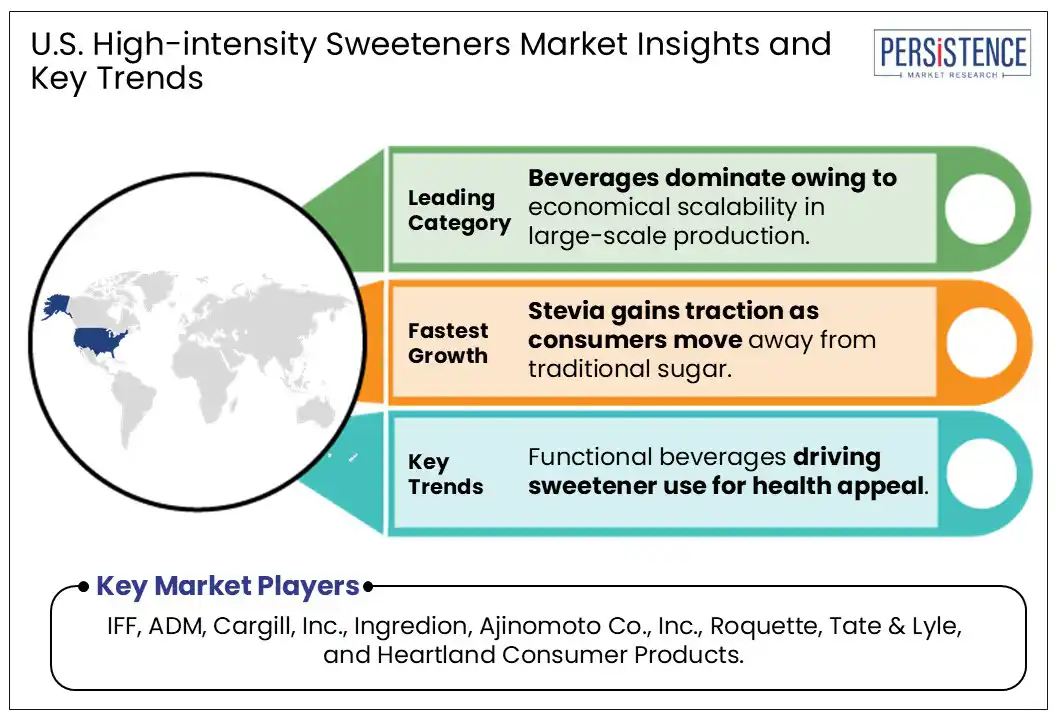ID: PMRREP34990| 177 Pages | 23 Jul 2025 | Format: PDF, Excel, PPT* | Food and Beverages

The U.S. high-intensity sweeteners market size is likely to be valued at US$ 1,149.3 Mn in 2025 and is estimated to reach US$ 1,774.3 Mn in 2032, growing at a CAGR of 6.4% during the forecast period 2025 - 2032.
The U.S. market has seen significant growth in recent years, due to innovations in food technology and the increasing prevalence of chronic conditions such as diabetes and obesity. For example, the Centers for Disease Control and Prevention’s (CDC) recent data indicates that the prevalence of obesity among adults aged 20 and over is around 42.9% in the U.S.
Consumers seek healthy sugar alternatives, increasing the popularity of sweeteners such as aspartame, sucralose, and stevia across various sectors, including beverages and confectionery. Innovations and the U.S. Food and Drug Administration (FDA) approvals for new sweeteners have extended opportunities for market players.
There is a surging demand for plant-based and natural sweeteners, boosted by trends in personalized nutrition and functional foods. The market is also observing the incorporation of high-intensity sweeteners in ready-to-eat meals and processed snacks. Sucralose, for instance, is 600 times sweeter than sugar, which makes it an economical option for producers. As less water and agricultural land are needed for cultivation than with traditional sugar crops, this efficiency lowers production costs and also supports sustainability objectives.

Key Industry Highlights
|
Global Market Attribute |
Key Insights |
|
U.S. High-Intensity Sweeteners Market Size (2025E) |
US$ 1,149.3 Mn |
|
Market Value Forecast (2032F) |
US$ 1,774.3 Mn |
|
Projected Growth (CAGR 2025 to 2032) |
6.4% |
|
Historical Market Growth (CAGR 2019 to 2024) |
5.3% |
The rising prevalence of chronic health conditions such as diabetes and obesity in the U.S. is driving demand for high-intensity sweeteners. For example, over 37 million individuals in the U.S. have diabetes, and nearly 100 million are classified as prediabetic, according to the Centers for Disease Control and Prevention (CDC). This surge has created a consumer base seeking healthy alternatives to traditional sugar.
As awareness of the negative effects of high sugar consumption is rising, more people are turning to sugar substitutes, such as aspartame, stevia, and saccharin. These sweeteners provide a sweet taste with minimal calories and do not raise blood sugar levels.
Their beneficial properties make them suitable for individuals looking to manage diabetes. Demand for sugar substitutes is further fueled by health campaigns promoting better eating habits and the need for dietary adjustments. As the number of diabetics increases, the market for sugar alternatives is likely to boom, reflecting a shift toward health-conscious choices in the U.S.
Technological innovations in formulation and production techniques are pushing the U.S. high-intensity sweeteners market growth. Over the past decade, developments in manufacturing processes have enhanced efficiency, quality, and cost-effectiveness. These have made sweeteners more appealing to both manufacturers and consumers.
Modern methods, such as fermentation and enzymatic processes, produce high-purity sweeteners with improved flavor profiles and reduced aftertaste. These help in addressing long-standing challenges with artificial sweeteners such as aspartame and sucralose.
Plant-derived sweeteners such as stevia and monk fruit are gaining popularity due to their natural appeal and low-calorie benefits. These are supported by innovations in biotechnology and efficient extraction techniques.
As consumer demand for clean-label products rises, manufacturers are focusing on developing sweeteners with fewer artificial ingredients. Innovations in blending techniques create balanced flavors that mimic sugar’s sweetness without negative health impacts.
Developments in high-intensity sweeteners are extending their applicability across various food & beverage categories. This innovation continues to drive consumer adoption, reduce costs, and increase availability in the U.S.
High-intensity sweeteners provide a sugar-free option for reducing calorie intake, but several consumers find the bitter aftertaste off-putting. This unpleasant flavor is often linked to sweeteners such as aspartame, saccharin, and sucralose, which leads to decreased preference. While these sweeteners are sweeter than sugar and have minimal or no calories, their taste often falls short of consumer expectations. To meet the rising demand for healthy products, manufacturers have started using blends of sweeteners or natural alternatives such as stevia.
The alternatives are thought to have less bitterness. However, these can be more expensive, and not all consumers react the same way to bitterness. Some may overlook it while others may reject products due to bitterness, and this variation complicates product development.
Collaborative partnerships are emerging as a key opportunity in the U.S. high-intensity sweeteners market, allowing companies to develop innovative products using natural sugar substitutes. A notable example is the August 2024 collaboration between Ajinomoto Health & Nutrition North America (AHN) and Shiru, aimed at using AI-powered protein discovery and fermentation to develop sweet proteins for use in beverages and specialty foods. This collaboration aims to produce natural sweeteners from fruits and berries near the equator, responding to the consumer demand for clean-label, minimally processed ingredients.
By combining resources, the two companies can quickly develop healthier alternatives to traditional sugars that align with the preference for natural ingredients and sustainability. These partnerships help expand market reach and introduce unique products that stand out in a competitive landscape. By offering alternatives that mimic sugar's taste and texture, these efforts are well-positioned to meet the rising demand for natural and sustainable products in the sweeteners market.
Stevia is expected to grow at a CAGR of 8.2% in the forecast period 2025 to 2032, as U.S. consumers are increasingly turning away from traditional sweeteners due to their associations with health issues such as diabetes and obesity, as they become more health conscious. Stevia, a natural sweetener derived from the leaves of the stevia rebaudiana plant, offers a calorie-free alternative.
A 2023 study by the International Food Information Council found that 73% of U.S.-based consumers were interested in natural sweeteners, indicating a trend toward healthy eating habits. Due to this inclination, brands are reformulating their products to use plant-based sweeteners.
It appeals to those looking to reduce their calorie intake without giving up sweetness. Rising demand for clean-label products and minimally processed ingredients aligns with the perception that stevia is a healthier choice compared to artificial sweeteners.
The clean-eating movement has encouraged consumers to seek products made with recognizable, natural ingredients, making stevia an ideal fit for this trend. Often marketed as a plant-based sweetener, stevia attracts consumers who follow vegan and plant-focused diets.
Innovations in extraction and formulation technologies have also improved the taste profile of stevia, significantly reducing the bitter aftertaste that has historically deterred some users. Enhancement in sensory quality, combined with strong marketing efforts, is contributing to high acceptance and usage of stevia across a wide range of food and beverage applications.
The beverages segment is projected to grow at a CAGR of 5.9% during the forecast period from 2025 to 2032. Increasing consumer health consciousness and a focus on weight management are driving the shift toward low-calorie beverage options. This trend is largely fueled by heightened awareness of the health risks associated with excessive sugar intake, including obesity and diabetes.
Manufacturers are increasingly using high-intensity sweeteners such as aspartame, sucralose, and stevia as sugar alternatives in various products, including sodas and iced teas. These are ideal for the beverage industry as they provide the desired sweetness with minimal to no calories. It makes them attractive to those wanting to reduce calorie intake without compromising taste.
Products labeled ‘diet’ or ‘sugar-free,” mainly appeal to individuals managing weight and blood sugar levels. The health and wellness trend further boosts the popularity of low-calorie beverages.
Consumers prioritizing fitness and well-being are pushing demand for these products. As the clean-label movement grows, there is a rising preference for natural sweeteners, which are seen as safer and healthier options.
The U.S. market is also experiencing a rise in plant-based and functional beverages incorporating natural sweeteners to maintain low-calorie profiles. For example, Bodyarmor SuperDrink recently launched Bodyarmor Zero Sugar, a unique beverage made for active hydration. It provides a blend of potassium-packed electrolytes, antioxidants, and vitamins B and C. It features zero sugar and is available in flavors such as fruit punch and lemon lime. This launch targets health-conscious consumers seeking functional, low-calorie hydration options.

The U.S. high-intensity sweeteners market is highly competitive as manufacturers race to deliver sugar alternatives that satisfy consumer expectations for taste, functionality, and health benefits. With demand surging across beverage, dairy, and processed food applications, companies are focused on developing advanced sweetening technologies that minimize bitterness and improve stability. R&D efforts are targeting enzymatic refinement, novel glycoside extraction, and fermentation-based production to enhance the purity and scalability of plant-based ingredients.
Companies are optimizing blends of high-potency sweeteners to replicate sugar’s mouthfeel while reducing aftertaste. Regulatory shifts toward transparent labeling and natural ingredient use are also shaping strategic formulations. Market players are leveraging clean-label appeal, targeting specific use-cases such as keto-friendly or diabetic-safe products.
Moreover, domestic sourcing and vertically integrated production models are gaining traction as companies aim to reduce cost pressures and ensure consistent supply in a competitive, health-driven market environment. Competitive strategies in the market involve product diversification, collaborative efforts, and a focus on clean-label and sustainable production. These are likely to help meet consumers' preferences for healthy, natural, and low-calorie options.
The U.S. High-Intensity Sweeteners market is projected to be valued at US$ 1,149.3 Mn in 2025.
The rising prevalence of diabetes and obesity is driving interest in the U.S. High-Intensity Sweeteners Market.
The U.S. High-Intensity Sweeteners market is poised to witness a CAGR of 6.4% between 2025 and 2032.
Collaborative partnerships to co-develop products with sugar alternatives is the key market opportunity.
Major players in the U.S. High-Intensity Sweeteners market include IFF, ADM, Cargill, Inc., Ingredion, Ajinomoto Co., Inc., Roquette, Tate & Lyle, and Heartland Consumer Products Group.
|
Report Attribute |
Details |
|
Historical Data/Actuals |
2019 - 2024 |
|
Forecast Period |
2025 - 2032 |
|
Market Analysis |
Value: US$ Mn |
|
Regional Coverage |
|
|
Segmental Coverage |
|
|
Competitive Analysis |
|
|
Report Highlights |
|
|
Customization and Pricing |
Available upon request |
By Product Type
By Nature
By Application
By Region
Delivery Timelines
For more information on this report and its delivery timelines please get in touch with our sales team.
About Author